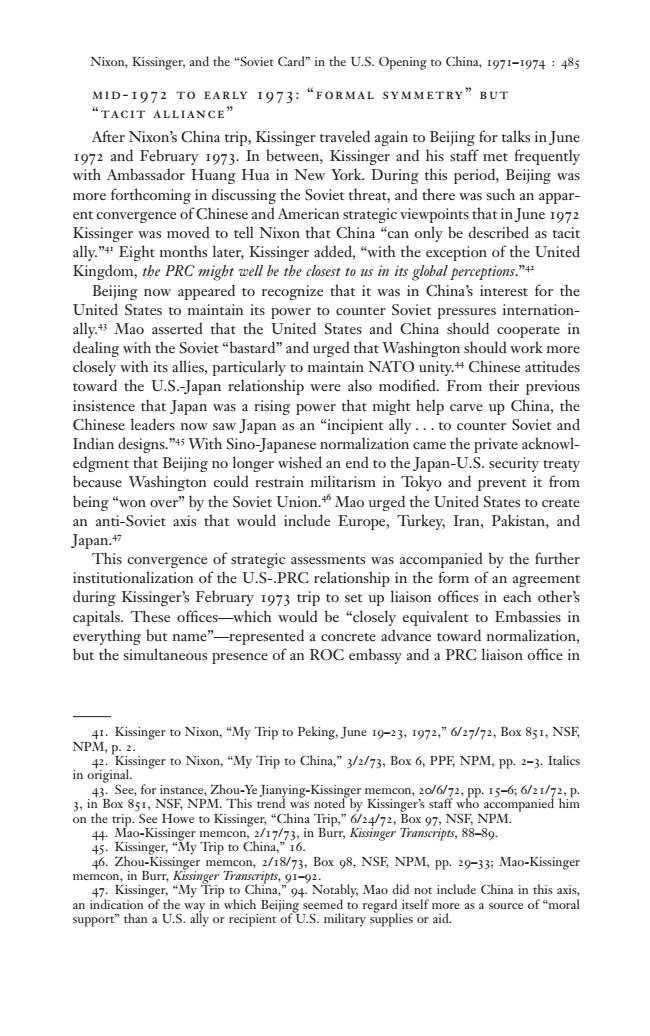正在加载图片...

Nixon,Kissinger,and the "Soviet Card"in the U.S.Opening to China,1971-1974 485 MID-I972 TO EARLY I973:“FORMAL SYMMETRY”BUT “TACIT ALLIANCE” After Nixon's China trip,Kissinger traveled again to Beijing for talks in June 1972 and February 1973.In between,Kissinger and his staff met frequently with Ambassador Huang Hua in New York.During this period,Beijing was more forthcoming in discussing the Soviet threat,and there was such an appar- ent convergence of Chinese and American strategic viewpoints that in June 1972 Kissinger was moved to tell Nixon that China "can only be described as tacit ally."+Eight months later,Kissinger added,"with the exception of the United Kingdom,the PRC mighbt well be the closest to us in its global perceptions."4 Beijing now appeared to recognize that it was in China's interest for the United States to maintain its power to counter Soviet pressures internation- ally.+3 Mao asserted that the United States and China should cooperate in dealing with the Soviet "bastard"and urged that Washington should work more closely with its allies,particularly to maintain NATO unity.#Chinese attitudes toward the U.S.-Japan relationship were also modified.From their previous insistence that Japan was a rising power that might help carve up China,the Chinese leaders now saw Japan as an "incipient ally...to counter Soviet and Indian designs."45 With Sino-Japanese normalization came the private acknowl- edgment that Beijing no longer wished an end to the Japan-U.S.security treaty because Washington could restrain militarism in Tokyo and prevent it from being"won over"by the Soviet Union.Mao urged the United States to create an anti-Soviet axis that would include Europe,Turkey,Iran,Pakistan,and Japan.+7 This convergence of strategic assessments was accompanied by the further institutionalization of the U.S-.PRC relationship in the form of an agreement during Kissinger's February 1973 trip to set up liaison offices in each other's capitals.These offices-which would be "closely equivalent to Embassies in everything but name"-represented a concrete advance toward normalization, but the simultaneous presence of an ROC embassy and a PRC liaison office in 41.Kissinger to Nixon,"My Trip to Peking,June 19-23,1972,"6/27/72,Box 851,NSF NPM,p.2. 42.Kissinger to Nixon,"My Trip to China,"3/2/73,Box 6,PPE,NPM,pp.2-3.Italics in original. 43.See,for instance,Zhou-Ye Jianying-Kissinger memcon,20/6/72,pp.15-6;6/21/72,p. 3,in Box 851,NSF,NPM.This trend was noted by Kissinger's staff who accompanied him on the trip.See Howe to Kissinger,"China Trip,"6/24/72,Box 97,NSF,NPM. 44.Mao-Kissinger memcon,2/17/73,in Burr,Kissinger Transcripts,88-89. 45.Kissinger,"My Trip to China,"16. 46.Zhou-Kissinger memcon,2/18/73,Box 98,NSF,NPM,pp.29-33;Mao-Kissinger memcon,in Burr,Kissinger Transcripts,91-92. 47.Kissinger,"My Trip to China,"94.Notably,Mao did not include China in this axis an indication of the way in which Beijing seemed to regard itself more as a source of "moral support"than a U.S.ally or recipient of U.S.military supplies or aid.mid-1972 to early 1973: “formal symmetry” but “tacit alliance” After Nixon’s China trip, Kissinger traveled again to Beijing for talks in June 1972 and February 1973. In between, Kissinger and his staff met frequently with Ambassador Huang Hua in New York. During this period, Beijing was more forthcoming in discussing the Soviet threat, and there was such an apparent convergence of Chinese and American strategic viewpoints that in June 1972 Kissinger was moved to tell Nixon that China “can only be described as tacit ally.”41 Eight months later, Kissinger added, “with the exception of the United Kingdom, the PRC might well be the closest to us in its global perceptions.”42 Beijing now appeared to recognize that it was in China’s interest for the United States to maintain its power to counter Soviet pressures internationally.43 Mao asserted that the United States and China should cooperate in dealing with the Soviet “bastard” and urged that Washington should work more closely with its allies, particularly to maintain NATO unity.44 Chinese attitudes toward the U.S.-Japan relationship were also modified. From their previous insistence that Japan was a rising power that might help carve up China, the Chinese leaders now saw Japan as an “incipient ally ... to counter Soviet and Indian designs.”45 With Sino-Japanese normalization came the private acknowledgment that Beijing no longer wished an end to the Japan-U.S. security treaty because Washington could restrain militarism in Tokyo and prevent it from being “won over” by the Soviet Union.46 Mao urged the United States to create an anti-Soviet axis that would include Europe, Turkey, Iran, Pakistan, and Japan.47 This convergence of strategic assessments was accompanied by the further institutionalization of the U.S-.PRC relationship in the form of an agreement during Kissinger’s February 1973 trip to set up liaison offices in each other’s capitals. These offices—which would be “closely equivalent to Embassies in everything but name”—represented a concrete advance toward normalization, but the simultaneous presence of an ROC embassy and a PRC liaison office in Nixon, Kissinger, and the “Soviet Card” in the U.S. Opening to China, 1971–1974 : 485 41. Kissinger to Nixon, “My Trip to Peking, June 19–23, 1972,” 6/27/72, Box 851, NSF, NPM, p. 2. 42. Kissinger to Nixon, “My Trip to China,” 3/2/73, Box 6, PPF, NPM, pp. 2–3. Italics in original. 43. See, for instance, Zhou-Ye Jianying-Kissinger memcon, 20/6/72, pp. 15–6; 6/21/72, p. 3, in Box 851, NSF, NPM. This trend was noted by Kissinger’s staff who accompanied him on the trip. See Howe to Kissinger, “China Trip,” 6/24/72, Box 97, NSF, NPM. 44. Mao-Kissinger memcon, 2/17/73, in Burr, Kissinger Transcripts, 88–89. 45. Kissinger, “My Trip to China,” 16. 46. Zhou-Kissinger memcon, 2/18/73, Box 98, NSF, NPM, pp. 29–33; Mao-Kissinger memcon, in Burr, Kissinger Transcripts, 91–92. 47. Kissinger, “My Trip to China,” 94. Notably, Mao did not include China in this axis, an indication of the way in which Beijing seemed to regard itself more as a source of “moral support” than a U.S. ally or recipient of U.S. military supplies or aid